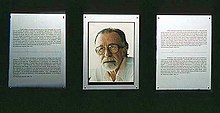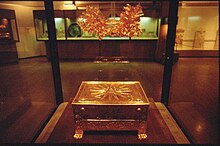Manolis Andronikos
This article needs additional citations for verification. (August 2009) |
Manolis Andronikos | |
|---|---|
 A picture of Andronikos in Vergina | |
| Born | October 23, 1919 |
| Died | March 30, 1992 (aged 72) |
| Nationality | Greek |
| Alma mater | University of Thessaloniki Oxford University |
| Known for | Discovering the tomb of Philip II of Macedon |
| Scientific career | |
| Fields | Archaeology |
| Institutions | Aristotle University of Thessaloniki |
| Influences | John D. Beazley |
Manolis Andronikos (Greek: Μανόλης Ανδρόνικος) (October 23, 1919 – March 30, 1992) was a Greek archaeologist and a professor at the Aristotle University of Thessaloniki.
Biography[]
Andronikos was born on October 23, 1919 at Bursa (Greek: Προύσα). Later, his family moved to Thessaloniki.
He studied philosophy at the Aristotle University of Thessaloniki and in 1952 became a professor of Classical Archeology at the Aristotle University of Thessaloniki. Later he continued his studies at Oxford University with professor Sir John D. Beazley (1954–1955). He came back to the Aristotle University of Thessaloniki in 1957 where he taught Archeology first as instructor and later (1964) as professor.

He was married to the school teacher Olympia Kakoulidou and loved reading poetry, especially Kostis Palamas, Giorgos Seferis and Odysseas Elitis. He was the founder of a local cultural group named Art (Greek: Η τέχνη).
Manolis Andronikos conducted archaeological research in Veroia, Naousa, Kilkis, Chalkidiki and Thessaloniki, but his main research was done in Vergina, where his teacher, professor K. Rhomaios had founded in 1937 the Aristotle University Excavation at Vergina. His greatest discovery occurred on November 8, 1977, when he found a tomb at Vergina which he identified as that of Philip II of Macedon. It was unplundered and contained many valuable items, such as a golden larnax.[1] The finds from this tomb were later included in the travelling exhibit "The Search for Alexander" displayed at four cities in the United States from 1980 to 1982.[2][3] While the discovery is of great archaeological importance, the identification of the tomb with Philip has been disputed by some archaeologists; that said, if the tomb is not Philip's, one of the others in the same complex probably is.[4]

Andronikos was a member of the Archaeological Council (1964–1965), the Athens Archaeological Association, the Macedonian Studies Association, the Association Internationale des Critiques d' Art and the German Archaeological Institute at Berlin. He lived permanently in Thessaloniki on Papafi Street and died on March 30, 1992.[5]
See also[]
- Ancient Macedonians
- Macedon
- Vergina Sun
Necrology[]
- Eugene N. Borza. "Manolis Andronikos, 1919-1992." American Journal of Archaeology 96.4 (Oct., 1992) 757–758.
References[]
- ^ Manolis Andronikos (1981). The Finds from the Royal Tombs at Vergina. Oxford University Press. ISBN 978-0-85672-204-2.
- ^ Nicholas M. Yalouris; Manolis Andronikos; Katerina Rhomiopoulou; National Gallery of Art (U.S.); Museum of Fine Arts (Boston) (1 November 1980). The Search for Alexander: An Exhibition. Little Brown. ISBN 978-0-316-77910-4.
- ^ Green, Peter (January 22, 1981). The Macedonian Connection. The New York Review of Books.
- ^ N.G.L. Hammond, "'Philip's Tomb' in Historical Context", GRBS 19 (1978), 331–50
- ^ Eugene N. Borza. "Manolis Andronikos, 1919-1992." American Journal of Archaeology 96.4 (Oct., 1992) 757-758.
External links[]
![]() Media related to Manolis Andronikos at Wikimedia Commons
Media related to Manolis Andronikos at Wikimedia Commons
- 1919 births
- 1992 deaths
- People from Bursa
- People from Hüdavendigâr Vilayet
- Aristotle University of Thessaloniki faculty
- Classical archaeologists
- Greek archaeologists
- Greek academics
- Herder Prize recipients
- 20th-century archaeologists